|
|
 |
Fiche d'espèce de Copépode |
|
|
Calanoida ( Ordre ) |
|
|
|
Diaptomoidea ( Superfamille ) |
|
|
|
Centropagidae ( Famille ) |
|
|
|
Centropages ( Genre ) |
|
|
| |
Centropages tenuiremis Thompson & Scott, 1903 (F,M) | |
| | | | | | | Syn.: | Centropages arabicus Cleve, 1904 (p.371, figs.);
Centropages yamadai : Mori, 1937 (1964) (p.59, figs.F,M); Yamazi, 1958 (p.149, Rem.); Tanaka, 1963 (p.11, figs.F,M); Koga, 1968 (p.17, fig.: egg); Itoh, 1970 a (p.4: tab.1); Kasahara & al, 1974 (p.170, fig. egg); Hirota & Uno, 1977 (p.77, fig. egg, seasonal abundance); Hanaoka, 1977 (p.267, 300, abundance); Grice & Marcus, 1981 (p.125, Dormant eggs, Rem.: p.133, 135, 137); Kim & al., 1993 ( p.269); Kotani & al., 1996 (tab.2); Sharaf & Al-Ghais, 1997 (tab.1); Mauchline, 1998 (p.506, tab.40); El-Serehy, 1999 (p.172, Table 1, occurrence); Ohtsuka & al., 2015 (p.123, Rem.: p.125);
Centropages kroyeri (M) : Mori, 1929;
Centropages orsinii (F) : Mori, 1929 p.174, figs.F) | | | | Ref.: | | | Thompson & Scott, 1903 (p.234, 247, figs.F,M); Sewell, 1912 (p.353, 363, figs.F,M, Rem.); 1914 a (p.221); 1932 (p.230, Rem. juv.); Brodsky, 1950 (1967) (p.317, figs.F,M); Shen & Bai, 1956 (p.220, figs.F,M, juv.); Shen & Lee, 1963 (p.577); Kasturirangan, 1963 (p.30, figs.F,M); Vervoort, 1964 b (p.309); Chen & Zhang, 1965 (p.73, figs.F,M); Saraswathy, 1966 (1967) (p.78, Rem.); Brodsky, (1950) 1967 (p.317, figs.F,M); Kos, 1976 (Vol. II, figs.F,M); Zheng Zhong & al., 1984 (1989) (p.244, figs.F,M); Chihara & Murano, 1997 (p.767, Pl.82,85: F,M); Mulyadi, 1998 (p.67, Redescr.F,M); Al-Yamani & Prusova, 2003 (p.61, figs.F,M); Mulyadi, 2004 (p.134, figs.F,M, Rem.); Phukham, 2008 (p.72, figs.M); Al-Yamani & al., 2011 (p.42, 47, figs.F); Ohtsuka & al., 2015 (p.123, Table 2); Prusova & al., 2019 (p.525, Table 3).
| 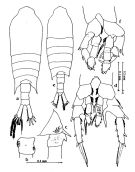 issued from : Mulyadi in The Raffles Bull. Zool., 1998, 46 (1). [Fig.8, p.68]. Female (Indonesian waters): a, habitus (dorsal view); b, genital complex (dorsal view); c, Th5 and genital complex (lateral view); d, P5. Male: e, habitus (dorsal view); f, P5.
|
 issued from : Tanaka O. in Publs Seto mar. biol. Lab., 1963, 11 (1). [Fig.153, p.12]. As Centropages yamadai. Female: a, P5. Male: b, Th5 and urosome (dorsal view); c, P5.
|
 issued from: Q.-c Chen & S.-z. Zhang in Studia Marina Sinica, 1965, 7. [Pl.25, 1-6]. Female (from E China Sea): : habitus (dorsal); 2, urosome (lateral left side); 3, P5 (posterior); 4, portion of right P5 (showing serrate on its 1st exopodal segment, posterior view). Male: 5, habitus (dorsal); 6, P5 (posterior).
|
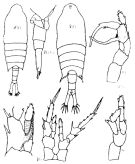 Issued from : K.A. Brodskii in Calanoida of the Far Eastern Seas and Polar Basin of the USSR. Opred. Fauna SSSR, 1950, 35 (Israel Program for Scientific Translations, Jerusalem, 1967) [p.318, Fig.220]. Female (from Sea of Japan): habitus (dorsal); urosome (lateral left side); S5, P5. Nota: P5 asymmetrical, right exopod 2-segmented, inner process of proximal segment more than 2/3 the length of the segment, covered with tubercles and denticles, basally curved and directed distally; left exopod 3-segmented, inner side of 2nd segment bearing process directed obliquely inward and distally, process half as long as that of right exopod; 2 nd segments of right and left ebdopodites covered with thin short bristles. Male: habitus (dorsal); S5, P5 (Le = left leg). Nota: Last thoracic segment asymmetrical processes, left one larger than the right.
|
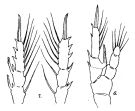 Issued from : R.B.S. Sewell in Rec. Indian Mus., 1912, 7. [Pl.XXIV, Figs.6-7]. Female (from Bay of Bengal): right P5. Male: 7, exopodites of P4.
|
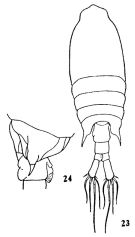 issued from : C.-j. Shen & S.-o. Bai in Acta Zool. sin., 1956, 8 (2). [Pl.III, Figs.23-24]. Female (from Chefoo): 23, habitus (dorsal); 24, last thoracic segment and genital segment (lateral left side).
|
 issued from : C.-j. Shen & S.-o. Bai in Acta Zool. sin., 1956, 8 (2). [Pl. IV, Figs.25-31]. Female: 25, P5. Nota: P5 asymmetrical; endopod 2 of right leg is pubescent on the posterior surface. Male: 26, habitus (dorsal); 27, A1; 28, P4; 29, P5. Nota: The outer distal spine on the right exopod 2 is pubescent and much bigger than the corresponding one of the left leg.
|
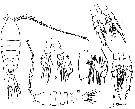 issued from : Mori T. in The pelagic Copepoda from the neifhbouring waters of Japan. S. Shirai ed., Tokyo; 1937; 2nd edit, 1964. [Pl.28]. As Centropages yamadaiFemale (35°27'30''-35°8'30'''N, 129°31'0''-129°10'30''E): 8, habitus (dorsal view); 10, genital segment (ventral view); 11, P5 (posterior). Male: 7, P4 (posterior); 9, P5; 12, habitus (dorsal view). Nota Female: - Lateral angles of the last thoracic segment symmetrical, projecting into the spines. - Genital segment symmetrical; the covering of the genital pore rounded, and no spines on that covering. - Caudal rami about 3 times as ling as breadth; terminal setae swelled at the proximal portions. - A1 extend beyond the end of the body by about the last 2 segments; there are no spines on the 1st, 2nd and 5th segments. - Endopodites of the legs P1 to P4 with 3 segments. - P5 somewhat resembles that of C. orsinii, these legs are symmetrical. The internal spine of the 2nd segment of exopodite of the right leg is curved, and has many spinules. The posterior side of the 2nd segment of endopodite of the tight leg is hairy. The 2nd segment of exopodite of the left leg has a common internal spine which has no spinules; and that spine is shorter than the segment itself . The posterior side of the 2nd segment odf endopodite of the P5 pair have a marginal seta on the inner margin. Nota male: - Caudal rami more than 3 times as long as its width. - The grasping A1 has a spine on the 18th segment. - There are 3 segments on the endopodites of the 4th pair of leg are stmmetrical. - Exopodites of the right P5 makes a graspuing organ. The thumb is shorter than the terminal claw: on that fact, this species differs from C. kröyeri.
|
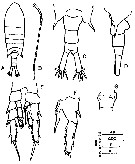 issued from : Y. Al-Yamani, V. Skryabin, A. Gubanova, S. khvorov & I. Prusova in Marine Zooplankton Practical Guide for the Northwestern Arabian Gulf, 2, 2011. [p.47, Fig.165]. Female (from Kuwait): A, habitus (dorsal); B, A1; C-D, posterior part of prosome and urosome (dorsal and right lateral, respectively); E, P5; F, right exopod of P5; G, genital segment (dorsal).
|
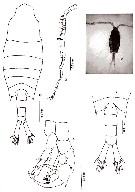 issued from : N. Phukham in Species diversity of calanoid copepods in Thai waters, Andaman Sea (Master of Science, Univ. Bangkok). 2008. [p.154, Fig.28]. Male (from W Malay Peninsula): a, habitus (dorsal); b, A1; c, urosome (dorsal); d, P5. Body length after the drawing: M = 1.284 mm.
|
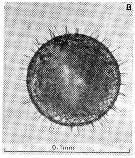 Issued from : R. Hirota & S. Uno in Bull. Plankton Soc. Japan, 1977, 24 (2). [p.80, Fig.3, B]. Pelagic eggs of Centropages yamadei ( = C. tenuiremis) from vicinity of Amakusa-Matsushima (western Kyushu, Japan).
|
 Issued from : I.Yu Prusova, E.A. Galagovets & E.V. Popova in Arthropoda Selecta, 2019, 28 (4). [p.525, Table 3]. Centropages tenuiremis: Characters for distinguishing between species of the hamatus group of the genus Centropages. Compare with the species C. hamatus, C. kroyeri, C. ponticus, and C. abdominalis.
| | | | | Ref. compl.: | | | Sewell, 1948 (p.323, 324); Krishnaswamy, 1953 (p.120); Ganapati & Shanthakumari, 1962 (p.8, 15); Stephen & Iyer, 1979 (p.228, tab.1, 3, 4, figs.3, 4); Chen Q-c, 1980 (p.794); Guangshan & Honglin, 1984 (p.118, tab.); Madhupratap & Haridas, 1986 (p.105, tab.1); Yoo, 1991 (tab.1); Dai & al., 1991 (p.45, tab.1); Hwang & Choi, 1993 (tab.3); Tiwari & Nair, 1993 (p.67); Myung & al., 1994 (tab.1); Shih & Young, 1995 (p.69); Ohtsuka & al., 1996 b (p.153, Rem.: p.166, diet); Liang & al., 1996 (p.527, Fig.3: seasonal variations, fig.14: abundance vs temperature); Ramaiah & al., 1996 (p.3); Marcus, 1996 (p.143); Park & Choi, 1997 (Appendix); Mauchline, 1998 (tab.40); Hsieh & Chiu, 1998 (tab.2); Achuthankutty & al., 1998 (p.1, Table 2, fig.6, 7, 8), seasonal abundance vs monsoon; Dalal & Goswami, 2001 (p.22, fig.2); Shimode & Shirayama, 2004 (tab.2); Rezai & al., 2004 (p.489, tab.2); Chang & Fang, 2004 (p.456, tab.1); Lan & al., 2004 (p.332, tab.1); Kasyan, 2004 (p.105); Kazmi, 2004 (p.228); Wang G. & al., 2005 (p.165, subitaneous and diapause eggs vs sinking rates); Rakhesh & al., 2006 (p.93, Table 2, spatial distribution); Hwang & al., 2006 (p.943, tab.I); Wu & al., 2007 (p.437); Dur & al., 2007 (p.197, Table IV); Humphrey, 2008 (p.83: Appendix A); Ohtsuka & al., 2008 (p.115, Table 5); Tseng L.-C. & al., 2008 (p.46, table 2, abundance vs moonsons, fig.8, table 3: indicator species); Rakhesh & al., 2008 (p.154, abundance vs stations); Fazeli & al., 2010 (p.153, Table 1); Shanthi & Ramanibai, 2011 (p.132, Table 1); Maiphae & Sa-ardrit, 2011 (p.641, Table 2); Zhang D. & al., 2011 (p.86, pH effects); Hsiao & al., 2011 (p.317, Table 2, indicator of seasonal change); DiBacco & al., 2012 (p.483, Table S1, ballast water transport); Mulyadi & Rumengan, 2012 (p.202, Rem.: p.204); Lee D.B. & al., 2012 (p.88, co-occurrence); Li & Gao, 2012 (p.699, sensitivity and respiration rates vs pH); D. Zhang & al., 2012 (p.30, effect of CO2 acidification); Moon & al., 2012 (p.1, Table 1); Jang M.-C & al., 2012 (p.37, abundance and seasonal distribution); Tachibana & al., 2013 (p.545, Table 1, seasonal change 2006-2008); Jagadeesan & al., 2013 (p.27, Table 3, seasonal abundance); Rakhesh & al., 2013 (p.7, Table 1, abundance vs stations); Zhang H. & al., 2013 (p.57, Rem. p.58); Suzuki, K.W. & al., 2013 (p.15, Table 2, 3, 4, estuaries, annual occurrence); Seo & al., 2013 (p.448, Table 1, occurrence); Zakaria & al., 2016 (p.1, Table 1, Rem.); Trottet & al., 2017 (p. 7, Table 3: resting stage); Ohtsuka & Nishida, 2017 (p.565, Table 22.1); Baumgartner & Tarrant, 2017 (p.387, resting eggs, Rem.) | | | | NZ: | 7 | | |
|
Carte de distribution de Centropages tenuiremis par zones géographiques
|
| | | | | | | | | | | |  issued from : C.T. Achuthankutty, N. Ramaiah & G. Padmavati in Pelagic biogeography ICoPB II. Proc. 2nd Intern. Conf. Final report of SCOR/IOC working group 93, 9-14 July 1995. Workshop Report No. 142, Unesco, 1998. [p.8, Fig.6]. issued from : C.T. Achuthankutty, N. Ramaiah & G. Padmavati in Pelagic biogeography ICoPB II. Proc. 2nd Intern. Conf. Final report of SCOR/IOC working group 93, 9-14 July 1995. Workshop Report No. 142, Unesco, 1998. [p.8, Fig.6].
Salinity ranges for C. tenuiremis in coastal and estuarine waters of Goa (India).
Shaded area indicates the range of higher abundance. |
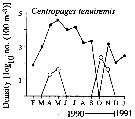 issued from : C.T. Achuthankutty, N. Ramaiah & G. Padmavati in Pelagic biogeography ICoPB II. Proc. 2nd Intern. Conf. Final report of SCOR/IOC working group 93, 9-14 July 1995. Workshop Report No. 142, Unesco, 1998. [p.6, Fig.5]. issued from : C.T. Achuthankutty, N. Ramaiah & G. Padmavati in Pelagic biogeography ICoPB II. Proc. 2nd Intern. Conf. Final report of SCOR/IOC working group 93, 9-14 July 1995. Workshop Report No. 142, Unesco, 1998. [p.6, Fig.5].
Monthly occurrence of Centropages tenuiremis in coastal (black circle) in front of Goa and and the Mandovi estuary (clear circle). |
 issued from : C.T. Achuthankutty, N. Ramaiah & G. Padmavati in Pelagic biogeography ICoPB II. Proc. 2nd Intern. Conf. Final report of SCOR/IOC working group 93, 9-14 July 1995. Workshop Report No. 142, Unesco, 1998. [p.3, Fig.2]. issued from : C.T. Achuthankutty, N. Ramaiah & G. Padmavati in Pelagic biogeography ICoPB II. Proc. 2nd Intern. Conf. Final report of SCOR/IOC working group 93, 9-14 July 1995. Workshop Report No. 142, Unesco, 1998. [p.3, Fig.2].
Hydrography of the coastal station in front of Goa and Mandovi estuarine station (W India).
Nota: The seasons are arbitrarily classified into the southwest monsoon (June-September), postmonsoon (October-January) and premonsoon (February-May). |
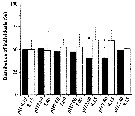 Issued from : W. Li & K. Gao in Mar. Poll. Bull., 2012, 64. [p.701, Fig.2]. Issued from : W. Li & K. Gao in Mar. Poll. Bull., 2012, 64. [p.701, Fig.2].
The pH sensitivity of Centropages tenuiremis: Distribution individuals when gave choice to pH 8.15 versus pH 8.15, pH 7.8 versus pH 7.8, pH 7.6 versus pH. 7.6, pH 7.0 versus pH 7.0, pH 7.0 versus pH 8.15, pH 7.6 versus pH 8.15 and pH 7.8 versus pH 8.15.
The symbol ''*'' above the columns indicate significant (p < 0.05) differences between the two pH treatments. Values in the columns indicate the numbers of repeated experiments. Vertical bar means ± SD (n= 8-91).
Nota: Individuals were obtain from surface water at the center of Xiamen Bay (24°26.778'N, 118°02.36'E), temperature 18-24°C, Salinity ±26 p.1000. The sensitivity to changes in acidity was determined as the proportions of the individuals at the areas of differed acidity. The test was carried out in drakness to eliminate the influence of light and at 20°C.
In the study, C. tenuiremis showed markedly avoidance behavior to lowered pH and preference to stay at the ambient level. The ability to perceive the chemical changes in seawater and to escape from the adverse circumstance is the key to survive in coastal waters where pH changes are specially large especially when eutrophisation and atmospheric CO2 rise interacts (see Cai W.-J. & al., 2011) |
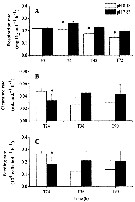 Issued from : W. Li & K. Gao in Mar. Poll. Bull., 2012, 64. [p.702, Fig.3]. Issued from : W. Li & K. Gao in Mar. Poll. Bull., 2012, 64. [p.702, Fig.3].
Rates of respiration and feeding by C. tenuiremis under ambient (LC, 390 µatm, pH 8.18) and elevated (HC, 1000 µatm, pH7.83) CO2 concentrations.
A: respiration; B: clearance; C: feeding rates.
The symbol ''*'' above columns indicate significant (p < 0.05) differences between the two pH treatments. Vertical bar means ± SD (n= 3-4).
Nota: To respond to and cope with the increased external acidity, C. tenuiremis increased its food acquisition to compensate for the extra energy demand via enhancement of respiration. The highter respiration rate found under the HC conditions coincided with increased demand for food, reflecting an up-regulated metabolism. Second generation may respond differentially to ocean acidification (see Dupont & Thorndyke, 2008)compared to the first one, therefore, findings in the present study only reflect a short-term response of the copepod. |
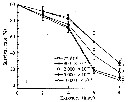 Issued from : D. Zhang, S. Li, G. Wang & D. Guo in Acta Oceanol. Sin., 2011, 30 (6). [p.89, Fig. 1 b]. Issued from : D. Zhang, S. Li, G. Wang & D. Guo in Acta Oceanol. Sin., 2011, 30 (6). [p.89, Fig. 1 b].
Influence of seawater acidification on survival rate in Centropages tenuiremis.
Average pH of each pCO2 seawater culture. Control (380) 8.16-8.17; (800) : 7.84-7.85; (2000): 7.39-7.37; (5000): 7.19-7.24; (10 000): 6.92-6.94. |
 Issued from : D. Zhang, S. Li, G. Wang & D. Guo in Acta Oceanol. Sin., 2011, 30 (6). [p.90, Fig. 2 b]. Issued from : D. Zhang, S. Li, G. Wang & D. Guo in Acta Oceanol. Sin., 2011, 30 (6). [p.90, Fig. 2 b].
Influence of seawater acidification on egg producton rate in Centropages tenuiremis.
Average pH of each pCO2 seawater culture. Control (380) 8.16-8.17; (800) : 7.84-7.85; (2000): 7.39-7.37; (5000): 7.19-7.24; (10 000): 6.92-6.94. |
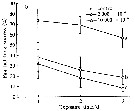 Issued from : D. Zhang, S. Li, G. Wang & D. Guo in Acta Oceanol. Sin., 2011, 30 (6). [p.91, Fig. 3 b]. Issued from : D. Zhang, S. Li, G. Wang & D. Guo in Acta Oceanol. Sin., 2011, 30 (6). [p.91, Fig. 3 b].
Influence of seawater acidification on egg hatching success in Centropages tenuiremis.
Average pH of each pCO2 seawater culture. Control (380) 8.16-8.17; (2000): 7.39-7.37; (10 000): 6.92-6.94.
Data are described as mean ± SD (n = 3). Different letters indicate a significant difference among elevated pCO2 levels at p < 0.05. |
 Issued from : D. Liang, S. Uye & T. Onbé in Mar. Biol., 1996, 124. [p.529, Fig.3] Issued from : D. Liang, S. Uye & T. Onbé in Mar. Biol., 1996, 124. [p.529, Fig.3]
Seasonal variations in total (nauplii + copepodites + adults abundances of Centropages abdominalis (filled circles) and Centropages tenuiremis (open circles) in Fukuyama Harbor (Inland Sea of Japan) from 7 November 1986 to 8 November 1987. |
 Issued from : D. Liang, S. Uye & T. Onbé in Mar. Biol., 1996, 124. [p.529, Fig.2] Issued from : D. Liang, S. Uye & T. Onbé in Mar. Biol., 1996, 124. [p.529, Fig.2]
Seasonal variations in temperature (open circles), salinity (filled triangles) and chlorophyll a concentration (filled circles) in Fukuyama Harbor from November 1986 to November 1987. |
 Issued from : D. Liang, S. Uye & T. Onbé in Mar. Biol., 1996, 124. [p.534, Fig.14] Issued from : D. Liang, S. Uye & T. Onbé in Mar. Biol., 1996, 124. [p.534, Fig.14]
Relationship between abundance and temperature for Centropages abdominalis ((filled circles) and Centropages tenuiremis (open circles). |
| | | | Loc: | | | Arabian Sea, Gulf of Oman, Arabian Gulf, UAE coast, Kuwait, Maldive & Laccadive Is., Sri Lanka, India (W, off Cochin, Bombay, Goa, Madras, Cochin, G. of Mannar, Palk Bay, Burhabalanga estuary, Lawson's Bay, ? Godavari region, Kakinada Bay), Bay of Bengal, Burma (coast), W Malay Peninsula (Andaman Sea), Straits of Malacca, Singapore, Indonesia (Java: Jakarta- Bay-Seribu Islands, off Tegal, off Surabaya), S Celebes Sea: Manado Bay, Hong Kong, China Seas (Bohai Sea, Yellow Sea, South China Sea, Xiamen Harbour & Bay, Jiaozhou Bay), Taiwan (SW, W, Kaohsiung Harbor, NW, N), S & W Korea, Muan Bay, Asan Bay, Korea Strait, Japan (Tokyo Bay, Tanabe Bay, Onagawa, Seto Inland Sea, south estuaries, Honshu: Suruga Bay), Sea of Japan (Amursky Bay), Korea (Ki-Channel, Bay of Fusan) off mouth of Amour River, S. Sakhalin, S Kuril Is., Pacif. (W equatorial), E Medit. (W Egyptian coast in Zakaria & al. (2016) | | | | N: | 78 (Medit.: 1; Indian: 23; Indonesia-Malaysia.: 5; Pacif.: 49) | | | | Lg.: | | | (22) F: 2-1,47; M: 1,8-1,3; (26) F: 1,5; M: 1,32-1,41; (44) F: 1,71; M: 1,428; (77) F: 2; M: 1,8; (91) F: 1,7-1,5; M: 1,54-1,27; (290) F: 1,6-1,35; M: 1,4-1,2; (351) F: 1,51-1,59; M: 1,3-1,35; (530) F: 1,8; M: 1,5; (776) F: 2-1,95; M: 1,8-1,75; (795) F: 1,8; M: 1,6-1,45; (937) F: 1,74-1,75; M: 1,60; (1122) F: 1,95; M: 1,8; {F: 1,35-2,00; M: 1,20-1,80} | | | | Rem.: | néritique.
Voir aussi les remarques en anglais | | | Dernière mise à jour : 01/01/2021 | |
|
|
 Toute utilisation de ce site pour une publication sera mentionnée avec la référence suivante : Toute utilisation de ce site pour une publication sera mentionnée avec la référence suivante :
Razouls C., Desreumaux N., Kouwenberg J. et de Bovée F., 2005-2025. - Biodiversité des Copépodes planctoniques marins (morphologie, répartition géographique et données biologiques). Sorbonne Université, CNRS. Disponible sur http://copepodes.obs-banyuls.fr [Accédé le 17 décembre 2025] © copyright 2005-2025 Sorbonne Université, CNRS
|
|
 |
 |

























